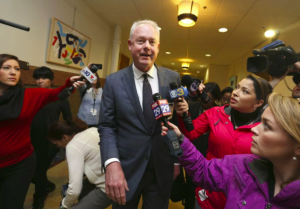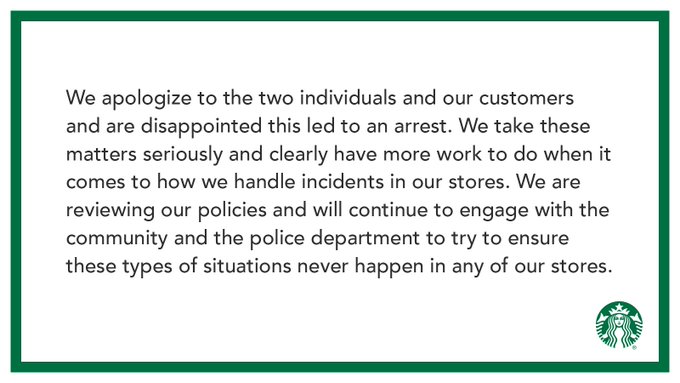04/19/18
From Washington Post:
“Though crisis communications adviser Mike Paul would have liked to see Johnson make that visit faster, he said it was ultimately the kind of human response the occasion called for:
‘When you have a highly flammable emotional situation like a racial crisis you must match it with a highly emotional solution in the opposite direction,’ he said, rather than a ‘legal solution’ or a ‘branding solution.’ Speaking about Johnson’s interview on CNN Tuesday night — the CEO appeared visibly shaken while speaking — Paul said ‘when I see a CEO with my buddy [host] Don Lemon being emotional, it feels like he was honest.”
Full story:
Anatomy of a PR response: How Starbucks is handling its Philadelphia crisis
Starbucks’ decision to close all 8,000 company-owned stores for an afternoon to hold “racial-bias” training raises an important question for companies wrestling with how to respond to crises amid racial tension in an era of social media: Can something be a grand gesture that goes above and beyond what many companies would do — yet still not be enough?
The company’s bold move, which was announced Tuesday and followed the social-media uproar and in-store protests that erupted after the arrest of two black men waiting at one of the coffee giant’s Philadelphia cafes, was mostly applauded by crisis management and diversity experts, some of whom called it a “courageous” or even “genius” gesture — especially following an initial statement that drew criticism.
“I think Starbucks is sending a strong message in doing this,” said Jeff Dickerson, a crisis communications adviser in Atlanta. “They’re bucking the trend, because ordinarily when large companies find themselves in this situation, they have counsel who will advise them against” admitting they’d done anything wrong.
Yet this is Starbucks, a brand that has positioned itself in our national consciousness as not just a restaurant chain or retail operation, but as a “third place” meet-up spot for the community. It has long been vocal about its progressive values, whether through its flawed #RaceTogether campaign or its founder’s musings on immigration or same-sex marriage, making an incident like the one in Philadelphia appear even more out of step than it would at other firms.
As a result, Starbucks had to do more in response than the average company. “You kind of expect Starbucks would do things like this,” said Paul Argenti, a professor at Dartmouth’s Tuck School of Business who studies corporate communication strategy. “The nail that sticks up gets beaten down. They had to do something more dramatic.”
The issue, of course, is racial bias — a complex, systemic problem that some observers said an afternoon of diversity training would do little to change, however well-intentioned or informed it may be. (The company is turning to names like Equal Justice Initiative founder Bryan Stevenson and the NAACP Legal Defense and Education Fund president for guidance.)
“You’re going to close your stores for an afternoon and take on 500 years of America’s brand of racism?” said Nicole Sanchez, CEO of Vaya Consulting. (Starbucks CEO Kevin Johnson has said several times that the May 29 training is only a “first step;” a Starbucks spokesperson did not immediately respond to requests for comment.)
Sanchez and other crisis communications experts said the company’s initial response could have been much stronger and more unequivocal. After video of the April 12 incident went viral, Starbucks first put out an apology two days later that didn’t mention race as an issue and drew criticism for being too legalistic.
“Their initial formal statement did not resonate well with the black community,” said Derede McAlpin, chief communications officer for the Association of Corporate Counsel, who has worked in crisis communications. “I think it didn’t address the heart of the issue.” ‘
On Sunday, he was out with a somber apology video where he took responsibility for the crisis, saying “the way that incident escalated, and the outcome, was nothing but reprehensible — and I’m sorry.” In response to calls to fire the store manager, Johnson said, “I believe that blame is misplaced. In fact, I think the focus of fixing this — I own it. This is a management issue and I am accountable to ensure we address the policy, and the practice and the training that led to this outcome.”
Gabrielle Adams, a professor at the University of Virginia who studies CEO apologies, said “in this climate, that kind of mea culpa is what’s needed.” In his apology, “he’s saying we recognize this is systemic and we don’t want to be part of it,” she said.
By Monday, Johnson sat face-to-face with the two men who’d been arrested in Philadelphia, as well as the city’s mayor and other officials. Though crisis communications adviser Mike Paul would have liked to see Johnson make that visit faster, he said it was ultimately the kind of human response the occasion called for.
“When you have a highly flammable emotional situation like a racial crisis you must match it with a highly emotional solution in the opposite direction,” he said, rather than a “legal solution” or a “branding solution.” Speaking about Johnson’s interview on CNN Tuesday night — the CEO appeared visibly shaken while speaking — Paul said “when I see a CEO with my buddy [host] Don Lemon being emotional, it feels like he was honest.”
But it was Starbucks’ move to close its stores that stood out the most to crisis management advisers. “Starbucks just upped the game for everyone,” said Carreen Winters, chief strategy officer for MWW Public Relations. Comparing the move to Chipotle’s 2016 decision to close its stores to deal with E. coli outbreaks, “what they’re basically saying is bias is at least as dangerous a problem as food safety.”
Some analysts have estimated the move could cost the company $7 million. And one of the key elements of a good apology, Argenti said, is to show that it involves some sacrifice: “It’s really hard to think about what other hit you could take than putting your money where your mouth is and getting rid of sales for an afternoon.”
Yet the real test will be what happens from here. A second allegation has already emerged in recent days, with a video suggesting a black Starbucks customer was not allowed to use a restroom in California while a white customer was. (In a prior statement provided to The Washington Post, a Starbucks spokeswoman said it took the incident seriously, saying “[we] are working closely with the team to learn from our mistakes” and “we are fully investigating our store practices and guidelines across the company.”)
“They’ve checked the boxes thus far, but people will be watching and looking after the dust has settled here,” Winters said. “They will be under the microscope more than ever before.”


